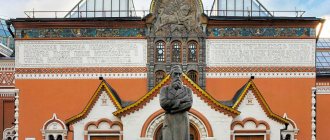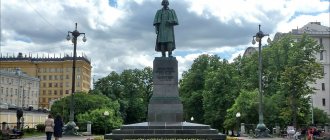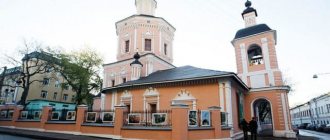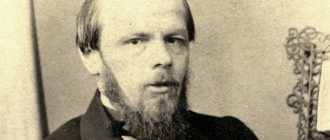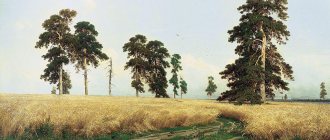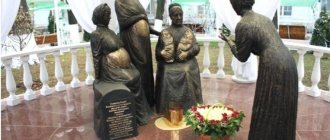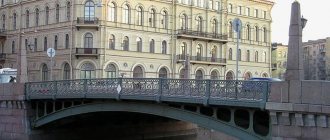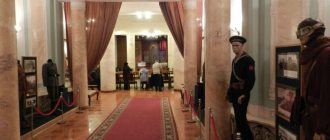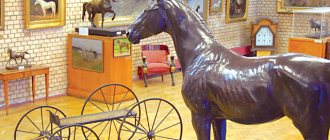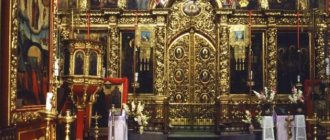is the largest museum of Russian art, world famous. The gallery is named after the Moscow merchant and industrialist Pavel Mikhailovich Tretyakov (1832–1898), who since 1856 has been collecting works by contemporary artists, wanting to “collect the Russian school as it is in its consistent course.”
Also on topic:
TRETYAKOVS
The history of the museum is usually counted from 1856, when Tretyakov acquired the first paintings. The gallery was conceived as a national museum of Russian art, accessible to a wide audience. The collector enjoyed the special confidence of the artists and received the right to inspect their new works in the studios, or already at exhibitions on the eve of the opening day. He bought paintings that interested him, often despite the opinion of critics, the prohibition of censorship, the pressure of recognized authorities, or even contrary to his own artistic taste.
Almost all the best that was created by members of the Association of Traveling Art Exhibitions (since 1870) was included in the gallery’s collection during P.M. Tretyakov’s lifetime. However, already in the early 1860s, works by painters of the 18th–1st century began to appear in the collection. 19th century, and later monuments of ancient Russian art.
Also on topic:
MUSEUMS
By the end of the 1860s, Tretyakov was planning to create a portrait gallery of the best people of the nation - “writers, composers and artists in general”; it was supposed to form a special section of the art gallery - the national portrait gallery. Tretyakov was guided by the enlightenment and very relevant for the worldview of the people of the 19th century. the idea of the role of the individual in history, which received wide resonance after the opening of the National Portrait Gallery in London in 1856, which Tretyakov visited during his trips to Great Britain. The involvement of leading Russian painters of the 1870s–1880s in the implementation of this idea stimulated the development of portraiture. Many portraits of Perov, Kramskoy, Repin, Yaroshenko were executed, if not directly ordered by Tretyakov, then with a deliberate orientation towards his portrait collection.
Tretyakov’s attention was also attracted by significant works by artists outside the circle of the Itinerants. So, in 1874 he bought the Turkestan series
V.V.Vereshchagina. Tretyakov was much less interested in the works of academic artists; he did not share the passion of his contemporaries for the work of Aivazovsky, and was wary of some innovations in painting in the 1890s.
Also on topic:
MUSEUM OF ART
Much less often than painting, Tretyakov acquired sculpture and graphics. Works of these types of art significantly replenished the museum after the death of its founder.
Briefly about the history of the creation of the Tretyakov Gallery
The Tretyakov Gallery was created in 1856. Its creator is considered to be the merchant Pavel Tretyakov. After 11 years, in 1867, the gallery was opened to visitors, and in 1892 the owner donated it to the city. Thus, the Tretyakov Gallery turned from a personal museum into state property.
Even at that time, the scope of the exhibition was striking - in 1892 the collection included more than 1,200 paintings, 471 drawings and about a dozen different sculptures.
In 1917, after the end of the revolution, the Tretyakov Gallery was nationalized, after which various things that belonged to private collections, both Russian and foreign, began to appear in it.
Currently, about 180 thousand different exhibits can be viewed in the gallery. The Tretyakov Gallery presents not only works by Russian and foreign artists, but also various products made of precious metals that have historical value.
Project of the facade of the Tretyakov Gallery, 1900
Gift to the city.
The intention to transfer the collection of paintings to the city was first expressed by Tretyakov in a testamentary letter of 1860. In 1892, Tretyakov donated his collection, as well as the collection of his brother Sergei Mikhailovich, which was passed to him by will (paintings and sculptures executed mainly by Western European masters). Moscow.
The collection consisted of 1287 paintings and 518 graphic works, 9 sculptures by Russian masters, 75 paintings and 8 drawings by European artists of the 2nd half. 19th century, mainly French and German.
In August 1893, the museum opened to the public for free viewing. From that moment until 1918, the museum was called the Moscow City Art Gallery of Pavel and Sergei Tretyakov.
P.M. Tretyakov was awarded the title of honorary citizen of Moscow.
Remaining a trustee of the Gallery until the end of his life, P.M. Tretyakov continued to acquire works with money allocated for these purposes by the Moscow City Duma and bequeathed by S.M. Tretyakov. Pavel Mikhailovich donated paintings purchased with his own money to the Gallery as a gift.
The catalog of the collection, compiled by Tretyakov shortly before his death (published in 1899), already contained 1635 paintings.
Modern activities
The Tretyakov Gallery building is located in Lavrushinsky Lane, house number 10. The average number of visitors is more than one and a half million people per year. The Tretyakov Gallery has several branches, which include the Engineering Building, several museum houses and even a temple in Tolmachi. In 2014, work began on the construction of another branch, which will be located in the Kadashevskaya embankment area. The gallery itself presents several exhibitions:
- Art of Ancient Rus' 12-17 centuries;
- 18th century art;
- 19th century art;
- Art of the early 20th century;
- USSR art and treasury.
The gallery itself consists of 106 halls, the exhibitions in each of them are carefully selected by painter and era.
Tretyakov family
Family P.M. Tretyakov. From left to right: Vera, Ivan, Vera Nikolaevna, Mikhail, Maria, Maria Ivanovna, Pavel Mikhailovich, Alexandra, Lyubov. 1884
The Tretyakovs belonged to an old merchant family, which traces its ancestry to the Kaluga province. Pavel Mikhailovich Tretyakov was born in 1832 and was the first-born. In total, there were 9 children in the family, but four of them died of scarlet fever, and then the father died, after which all movable and immovable property passed to the brothers Pavel and Sergei, who successfully continued their father’s work. Pavel Mikhailovich married late, in 1865, but was very happy in his family. He had 6 children. Everyone in the family loved each other. Pavel Mikhailovich Tretyakov wrote to his wife: “I sincerely thank God and you from the bottom of my heart that I had the opportunity to make you happy, however, the children have a lot of blame here: without them there would be no complete happiness!” Many years later, recalling these days, the eldest of the daughters, Vera Pavlovna, will write in her memoirs: “If childhood can really be happy, then my childhood was like that. That trust, that harmony between loved ones who loved us and cared for us, was, it seems to me, the most valuable and joyful.” In 1887, Vanya, everyone’s favorite, his father’s hope, died of scarlet fever complicated by meningitis. Pavel Mikhailovich was very sad. He gave his daughters an excellent education at home. Music, literature, foreign languages, concerts, theaters, art exhibitions, travel - these are the components of home education in the Tretyakov family. Artists, writers, musicians, including I.S., visited their house. Turgenev, P.I. Tchaikovsky, A.G. Rubinstein, I.E. Repin, I.N. Kramskoy, V.M. Vasnetsov, V.G. Perov, V.D. Polenov and many others. The Tretyakov family loved traveling, both within the country and abroad.
Sergei Mikhailovich Tretyakov
Pavel Mikhailovich worked a lot: most of his time was taken up by commercial and industrial affairs - management of the Kostroma flax spinning factory, shops and others, and all the remaining time was devoted to the gallery (visiting exhibitions, artists, construction work in the gallery, hanging, compiling a catalog, etc.) . There were also charitable activities, which we mentioned above, as well as participation in the activities of the Orthodox Missionary Society, he was involved in the care of the poor, was a member of the Commercial Court, and was a member of various societies - artistic, charitable, commercial. According to his will, large sums of money were allocated for the maintenance of the gallery, the Arnold School, various scholarships, etc.
Interesting Facts
1. The formation of the gallery as a collection of the merchant Tretyakov began with the purchase of Western European paintings, and not works of Russian artists. 2. Few people know that Pavel’s younger brother, Sergei, also took part in the creation of the gallery. 3. The emblem of the famous museum is the facade of the building. It was made according to Vasnetsov’s sketch. 4. In the museum you can find the painting “Ivan the Terrible and his son Ivan November 16, 1581.” In 1913, she was “attacked” - a man whose identity could not be established struck the canvas several times with a sharp knife. 5. During the entire existence of the Tretyakov Gallery, it was closed several times - due to thefts and during military operations. 6. In 1999, the Gallery was presented with the Miraculous Icon of the Mother of God, which, according to legend, was able to save Moscow from the attack of Khan Mahmet-Girey. 7. The idea of creating a private gallery on a huge scale came to the merchant’s mind after visiting the famous St. Petersburg Hermitage. 8. The painting that started it all – “Skirmish with Finnish Smugglers.” 9. In 1891, the first theft from the Tretyakov Gallery occurred, as a result of which 4 paintings disappeared, 2 of which were returned. 10. In the famous painting “Morning in a Pine Forest,” the bears were painted by another artist. However, Shishkin erased Savitsky's name with turpentine, leaving all the work behind him.
The artistic taste of P.M. Tretyakov
Pavel Mikhailovich Tretyakov
There are legends about this. His taste was so unquestionable, and his artistic sense was so subtle that no one dared to buy the painting he had eyed at the exhibition, not even, they say, the emperor. Focused and silent (his family called him “unsmiling”), P.M. Tretyakov appeared at the opening of the exhibition and chose an unknown painting, bought it - almost unmistakably guessing the future masterpiece in it. “This is a man with some kind of devilish instinct,” the artist Kramskoy once said about him.
In the 1860s, Tretyakov acquired the paintings “Prisoners’ Halt” by V.I. Jacobi, “The Last Spring” by M.P. Klodt, “Grandma’s Dreams” by V.M. Maksimova and others. Pavel Mikhailovich highly appreciated the work of V.G. Perov, to whom he wrote in October 1860: “Take care of yourself for the service of art and for your friends.” In the 1860s, works by Perov were acquired: “Rural religious procession at Easter”, “Troika” and “Amateur”; Subsequently, Tretyakov continued to acquire paintings by Perov, commissioned portraits from him, and actively participated in organizing a posthumous exhibition of the artist’s works.
V. Perov “Troika”
In 1864, the first painting based on Russian history appeared in the collection - “Princess Tarakanova” by K.D. Flavitsky.
P.M. Tretyakov loved nature and subtly understood it, so the acquisition of landscapes was always not accidental. In the 1860s, paintings by L.F. appeared in his collection. Lagorio, A.P. Bogolyubova, M.K. Klodt, I.I. Shishkina. He wrote: “I don’t need rich nature, no magnificent composition, no spectacular lighting, no miracles, give me even a dirty puddle, but so that there is truth in it, poetry, and there can be poetry in everything, that’s the artist’s job.”
Portraits occupied an important place in Tretyakov's collection. By the end of the 1860s, he planned to create a portrait gallery of outstanding figures of Russian culture - composers, writers, artists. He began not only to buy already created works, but also to order portraits. For example, Perov, at the request of Tretyakov, painted portraits of A.N. Ostrovsky, F.M. Dostoevsky, A.N. Maykova, M.P. Pogodina, V.I. Dalia, I.S. Turgenev; I.N. Kramskoy – portraits of L.N. Tolstoy, M.E. Saltykova-Shchedrina, S.T. Aksakov and N.A. Nekrasova.
The history of the creation of the portrait of L.N. by I. Kramskoy Tolstoy
I. Kramskoy “Portrait of L.N. Tolstoy"
Tretyakov wanted to have a portrait of Tolstoy back in 1869, but the writer flatly refused to pose. Tretyakov tried to act through Fet, counting on his friendship with Tolstoy, but was refused: “As for the portrait, I spoke directly and say: no... There is some feeling, stronger than reasoning, which tells me that this is not suitable.” Only in 1873 I.N. Kramskoy managed to persuade him. And it happened like this. In the summer of 1873, Kramskoy and his family lived in a dacha in Kozlovka-Zasek, near Tula. Visits Leo Tolstoy in Yasnaya Polyana, but he continues to refuse to pose. Next, let's listen to the artist himself, who writes to Tretyakov: “My conversation lasted more than two hours, I returned to the portrait four times and all to no avail... One of the last arguments on my part was the following: I respect too much the reasons why your Excellency refuses sessions , in order to insist further, and, of course, I will have to forever abandon the hope of painting a portrait, but your portrait should and will be in the gallery. “How so?” It’s very simple, I, of course, won’t paint it, and neither will any of my contemporaries, but in thirty, forty, fifty years it will be painted, and then all that will remain is to regret that the portrait was not done in a timely manner. He thought about it, but still refused, although hesitantly... I began to make concessions to him and reached the following conditions, to which he agreed: firstly, the portrait will be painted, and if for some reason he does not like it, it will be destroyed, the time of its arrival in your gallery will depend on the will of the count, although it is considered your property... And then it turned out that he would like to have a portrait for his children, but he didn’t know how to do it, and asked about a copy... and from him It will depend on which one he keeps and which one goes to you. At this point we parted and decided to start the sessions tomorrow...”
This is how this portrait of Tolstoy was created. Kramskoy managed to break Tolstoy's moral resistance and open the way to Tolstoy for many artists. But Kramskoy convinced P.M. of the need for this portrait. Tretyakov.
